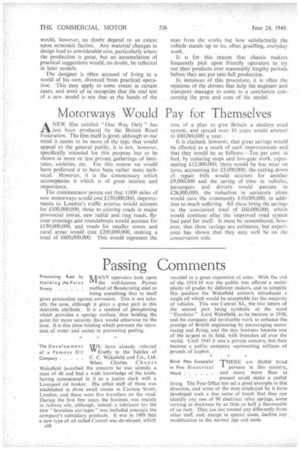Drivers' Views on Vehicles
Page 1

Page 2

If you've noticed an error in this article please click here to report it so we can fix it.
AN interesting case for the paying of more attention to the driver's point of view, as regards the design of chassis and bodywork has been laid before us. It was said that operators' requirements in respect of these, and the attention given to them by chassis manufacturers and bodybuilders, sometimes omitted items which would add to the comfort of those at the wheel, and even promote road safety from the driving point of view. It was thought that drivers could, if they were given the opportunity, make a valuable and reasonably unbiased contribution to the improvement of even modern designs, and we must say that certain points put to us showed intelligence and practical knowledge which might well help towards the production of vehicles which would be more appreciated by all concerned.
Examples of alleged faults in design were forthcoming. One driver, of what might be considered average height, said that in the particular vehicle he drove the steering wheel was so high and at such an angle that he had to view the road by Looking between the spokes—an awkward procedure and one which cannot be considered as a contribution to safe driving. Apart from these points, a high wheel tends to drain the blood from the arms, causing bad circulation which is apt to result in chilling in cold weather and armtiredness at any time.
Comfort With Forward Control Then it was asked why, in a vehicle with fullforward control with the engine in the cab, the hotter parts could not be arranged at the side away from the driver. He can usually keep reasonably warm, and in hot weather perhaps excessively so, whereas the mate, who has nothing to do while the vehicle is moving, would be kept warmer in cold weather and not be so troubled in hot.
Some men also complain that certain vehicles, when fully laden, are apt to sway to an alarming extent on curves and corners or where roads are excessively cambered. This is experienced with some modern machines and they ask why, if this can be avoided in some designs, it cannot he obviated in others. We fully appreciate that the man who is at the wheel for the greater part of his working.life should be a good judge of such points, and the problem is how to take advantage of any such knowledge. Individual pleas are unlikely to receive much attention, but where a number of drivers is concerned, one might be deputed to collect notes of this description and put them forward to some responsible executive, for instance, the engineer or transport manager.
The Institute of Road Transport Engineers has machinery devised to deal with matters of this type. Panels have been formed, each constituted from engineers concerned with a particular class of vehicle, and any comments from these panels are considered by a central committee. Where considered necessary, the action taken is to prepare a report with recommendations, and submit this to the maker or makers-concerned, the report, and any reply, being treated aslconfidential.
Pay Attention to Suggestions The membership of the Institute is now so large and widespread that a considerable proportion of the operating engineers is included. We would, therefore, ask them to pay every attention to useful suggestions from the drivers of the vehicles which they maintain, and where thought necessary pass these to the panels. Thus, a further valuable link would be forged.
It might be possible to organize competitions amongst drivers of fleets and offer small prizes for the best suggestions, as is the practice in many engineering and manufacturing concerns. It is difficult to say what results would be achieved. These would depend largely upon the enthusiasm of the personnel, but at least the scheme would provide opportunities which are so often not now available and would indicate to the men that their views were receiving full consideration., It would be quite easy to distinguish between the constant grouser and the man who is really keen on his work and who wishes to make a contribution to the general good.
We are sure that chassis makers and bodybuilders would welcome constructive criticism from any source. The action taken by them *27 would, however, no doubt depend to an extent upon economic factors. Any material changes in design lead to considerable cost, particularly where the production is great, but an accumulation of practical suggestions would, no doubt, be reflected in later models.
The designer is often accused of living in a world of his own, divorced from practical operation. This may apply to some extent in certain cases, and most of us recognize that the real test of a new model is not that at the hands of the man from the works but how satisfactorily the vehicle stands up to its, often gruelling, everyday work.
It is for this reason that chassis makers frequently pick upon friendly operators to try out their products over reasonably lengthy periods before they are put into full production.
• In instances of this procedure, it is often the opinions of the drivers that help the engineer and transport manager to come to a conclusion concerning the pros and cons of the model.




























